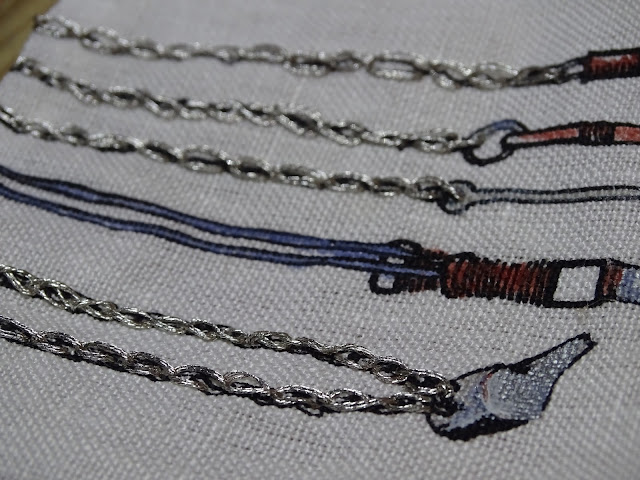During Victorian times, woman - and not just mill working woman - took to wearing a long slender shawl called the Sontag, named after the German singer called Henrietta Sontag who brought it to the attention at that time. It wrapped around the shoulders and the back of the neck, crossed over at the front and was either tied or tucked into a belt at the back. The earliest written pattern found for the Sontag was in the 1860s.
It felt fitting that Millie should have one as it would allow me to incorporate elements of Himself's work in textiles. The hessian itself originated from India, transported to Forfar in Scotland and then down to the textile mills in the northern England. The wools are 100% British wools from mills in Huddersfield in West Yorkshire. So a rough and hardworking Sontag was made for Millie, to keep from being cold in the linen mills during chilly early starts.Her skirt was given a patch - using a snip of linen left from cutting out the pattern, it felt right to use every last scrap, then simple boro mending was applied - to allow it to be both functional and decorative.
The original fabric doll had printed hair ribbons holding her plaits back. However, once the body was sewn and stuffed, these once prominent ribbons seemed to flatten out - so strips of red fabric were retrieved from the snippety-bits-basket and attached. Ribbons were very expensive and so would have been precious and worn with pride and love.
The working mill woman would have had a simple working style of chatelaine belt, not decorative but a purely functional version where all the tools of the trade were hung and in this case a whistle which would have been used to be able to be heard above the clatter of the weaving machines. Most mills were several stories high and the noise would have been almost unbearable. Millies learnt to lip read so they could communicate during the long working day which usually started at 6am, finishing at 6pm with an hour for lunch. Aprons were not just the domain of the working class, nearly everyone had some form of pinafore or apron to protect their clothing. With needing to protect the few items of clothing they had not just from wear and tear but from general dirt, a protective pinny or apron was worn by both women and men, rich and poor alike.










Super. From a Yorkshire lass.
ReplyDeleteI knew you were a northern lass, but not from where :) Na then Jill - sithee x
DeleteYour words and Millie herself bring alive the world of poor working women. It's horrible to think of them having to work with such noise.
ReplyDeleteThank you - quite a health hazard in itself - all that noise, I don't think I could do it, my hat is off to these ladies.
DeleteShe is looking fabulous; I'm impressed with the research you've done and love the additional patch with boro mending. I can feel you are having a lot of fun with her. x
ReplyDeleteThank you! some of the things I am writing about I have 'absorbed' from living her in the north with an interest in textiles, others I have researched and have really enjoyed doing so - and yes, I am having fun!
DeleteI'm in awe of the research you've done & how you've applied it to the doll. I've enjoyed being with you in each application & hope together your date goes well. Now I'm thinking about my ancestors from Almondbury (nr. Huddersfield) & if maybe some of them worked in the mills......Take care, stay safe & huggles.
ReplyDeletethanks Susan, I have always enjoyed research and if I had a second change at life I might have gone into that line of career - so now I just do it because I find research really interesting
DeleteWhat an interesting post! A real eye opener. Splendid how you have given us the back-ground and all those details to be able to imagine what Millie's working life was like. Fascinating research! My sister sent me a couple of DVDs of the series The Mill part 1 & 2 which is about mill workers in 1830s. I don't know how veridical the plot of the series is but I did find it very interesting to watch. I remember that you see in the series how little children had to crawl under the looms to untangle thread as quick as possible...dangerous task! They started working in the mill at just nine years old!! Millie is coming along very well. keep well Amanda x
ReplyDeleteThanks Amanda, it is quite well documented how many children worked in the mills, to help supplement the wages of the parents and to be able to sneak under the looms to collect the fluff or fallen thread - it was easier to send a small child that try as an adult to clamber down.
DeleteI am loving this series of posts. How you are weaving the history into your creating, thank you for sharing x
ReplyDelete